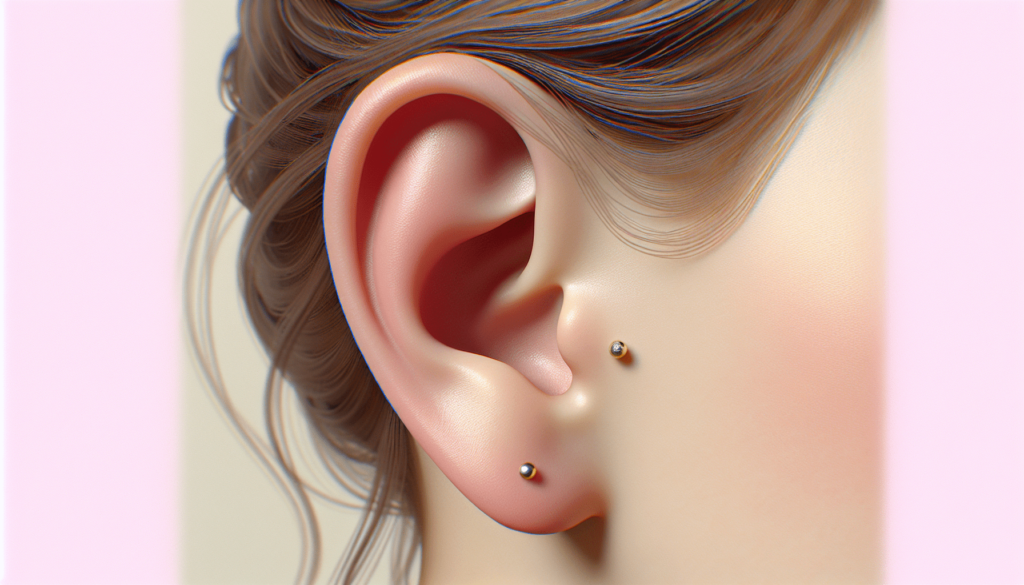Do you want a new ear piercing but are worried about the possibility of rejection? Getting your ears pierced can be an exciting event, but it comes with its share of concerns. One of the most common worries is piercing rejection, where the body treats the new piercing as an unwelcome guest and works to push it out. With the right knowledge, you can significantly reduce these chances and maintain that new sparkle in your ear without any issues. Let’s dive into some essential tips for ear piercing rejection prevention. By the way, if you’re looking for comprehensive training, consider our Ear Piercing Online Course from Centre of Wellness.

Understanding Ear Piercing Rejection
What is Ear Piercing Rejection?
Ear piercing rejection occurs when your body sees the jewelry as a foreign object and tries to push it out. It’s the body’s way of protecting itself from potential threats. Symptoms can include redness, swelling, and the jewelry moving towards the surface of the skin. In some cases, the body expels the jewelry completely.
Why Does Rejection Happen?
Rejection mostly happens due to incorrect technique, inappropriate jewelry, or your body’s unique reactions. It’s crucial to understand the factors contributing to it to better prevent it.
Causes of Rejection:
| Cause | Description |
|---|---|
| Incorrect Jewelry Choice | Using metal that your body reacts negatively to, like nickel. |
| Inadequate Hygiene | Poor aftercare practices leading to infections. |
| Excessive Trauma | Constant pressure or movement causing disruption in the healing process. |
| Genetic Factors | Some individuals naturally have more sensitive skin or a predisposition to rejection. |
Tips for Preventing Ear Piercing Rejection
Choose the Right Piercing Professional
Selecting an experienced and skilled professional can make a world of difference. They will know how to place the piercing correctly and use the best materials, reducing your risk of rejection. Always check for certifications and reviews before making a choice.
Opt for the Appropriate Jewelry
The type of jewelry you choose can have a significant impact on the outcome of your piercing. Here’s a table to guide you:
| Jewelry Type | Characteristics | Why It’s Recommended |
|---|---|---|
| Implant-Grade Titanium | Hypoallergenic, less reactive | Reduces chances of rejection and infection |
| Surgical Stainless Steel | Contains small amounts of nickel, but generally safe | Affordable and commonly used |
| Niobium | Hypoallergenic, similar properties to titanium | Suitable for sensitive skin |
| Gold (14k or higher) | Should be nickel-free and of high quality | Less likely to cause reactions |
Remember, always avoid cheap materials that can cause irritation and rejection.
Maintain Proper Aftercare
Aftercare is pivotal to a successful and healthy piercing. Here are some steps for optimal aftercare:
-
Cleaning: Clean your piercing twice a day with a saline solution or a piercing care product recommended by your professional.
-
Avoid Touching: Refrain from touching or twisting the jewelry, as your hands can introduce bacteria.
-
Shower Hygiene: Ensure you clean your piercing while showering, as soap residue can cause irritation.
-
Sleep Safely: Avoid sleeping on the piercing to prevent unnecessary pressure and trauma.
-
Avoid Submersion: Stay away from pools, hot tubs, and any water bodies that may introduce bacteria.
Keep an Eye Out for Infections
Even with the best care, infections can happen. Early signs include prolonged redness, soreness, and unusual discharge. If you notice any of these, consult a healthcare professional immediately. Properly managing infections can prevent the likelihood of rejection.
Avoid Excessive Physical Activity
If you’re someone who loves a rigorous workout or contact sports, take special care. Sweating and excessive movement can aggravate the piercing site. Use protective caps if necessary, and make sure to clean the area thoroughly post-workout.
Keep Stress at Bay
Believe it or not, stress can impact your body’s healing process. Ensure you’re in a good mental state before getting a piercing, and manage stress levels through relaxation techniques, exercise, and sleep.
Regularly Follow-Up
Make it a point to visit your piercing professional for a follow-up. They can assess the healing process and address any concerns you might have.
How Our Ear Piercing Online Course Can Help
Gaining proper knowledge about ear piercings is crucial. The Centre of Wellness offers an extensive Ear Piercing Online Course designed to arm you with all the necessary information and techniques. Whether you’re a beginner or need a refresher, this course covers:
- The Anatomy of the Ear: Understanding where and how to pierce.
- Sanitation Practices: Detailed steps on maintaining a hygienic environment.
- Jewelry Selection: Guidance on choosing the best materials for your clients.
- Aftercare Instructions: Comprehensive aftercare for varied piercings.
- Troubleshooting: Recognizing and addressing issues early on.
It’s an investment in your skill and the health of your clients. For more information, check out the course here.
Conclusion
Ear piercing rejection need not be a daunting concern. With the right professional technique, appropriate jewelry, diligent aftercare, and a bit of knowledge, you can significantly diminish the risk. Equip yourself with these tips, stay informed, and consider taking our detailed Ear Piercing Online Course to enhance your understanding and skills. Here’s to a successful and safe piercing experience!


